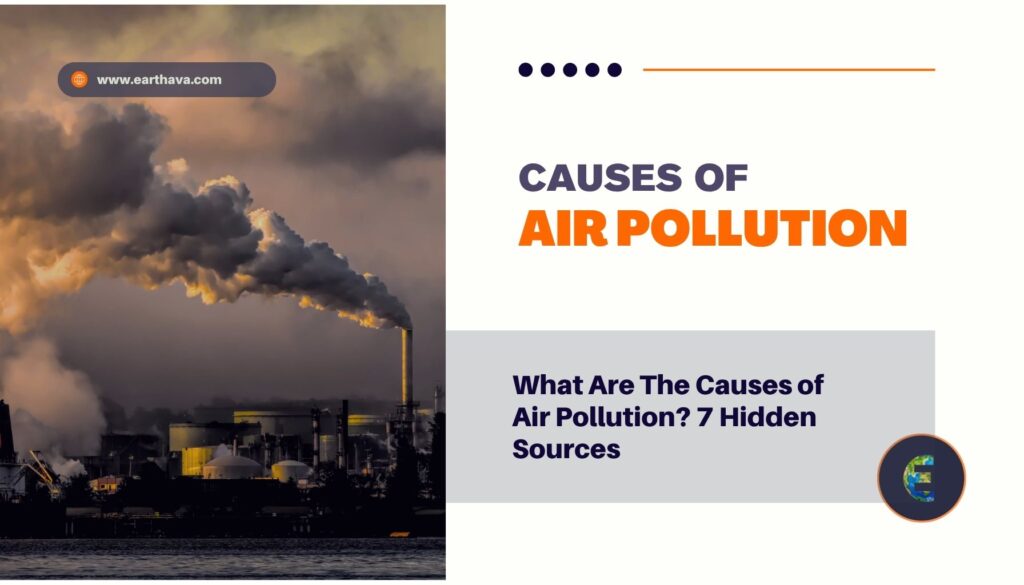Wondering what causes air pollution? It’s more than just cars and power plants—everyday activities like cooking, cleaning, and even certain paints add to the mix. These pollutants don’t just cloud our skies; they can harm our lungs and even our climate.

Pollution has become a commonplace term that your ears might now be attuned to. You read about it and hear about its various forms in the mass media. Air pollution is one such form. It results from chemical, biological, or physical contamination of air.
The causes are mainly smoke, dust, and other harmful gases that enter the atmosphere. These contaminants make it difficult for humans, plants, and animals to survive because they make the air unclean.
Have you ever considered how much pollution you breathe in daily? No one is safe from pollution because the causes of pollution are everywhere, even in homes.
Air pollution is more deadly than you think. Air pollutants are detrimental to human health and the planet as a whole. Learn the causes of air pollution here.
The Causes of Air Pollution
Transport
The transport sector accounts for the majority of carbon dioxide emissions globally. Unfortunately, this proportion is still rising at an alarming rate. Premature deaths have been linked to air pollution emissions from the transport sector.
Almost 50 percent of these deaths are caused by burning diesel. It has also been reported that up to 4 million children annually live closest to major traffic arteries and are more likely to be diagnosed with asthma.
An intervention is needed to reduce vehicle emissions to improve the quality of air, especially in urban areas. Standards and policies that require advanced vehicle emission standards and the use of cleaner fuels can reduce vehicle emissions drastically.
Agriculture
The use of fertilizers, pesticides, and insecticides in agriculture has grown to unimaginable levels. These chemicals emit harmful compounds into the atmosphere, which pollute the air.
One of the most hazardous gases that comes from agriculture-related activities is ammonia. Livestock not only produce ammonia but also methane. Methane is among the major causes of air pollution.
Methane is also produced in rice paddies. This gas contributes to the formation of ozone, a gas known to cause respiratory illnesses such as asthma. Methane is also one of the gases that cause global warming – it is even worse than carbon dioxide.
Agriculture is also a dominant source of ammonia. Ammonia is emitted into the air, which causes acidic rain that acidifies soils, lakes, and rivers.
Farmers can improve grassland and grazing management. It optimizes feed digestibility by livestock to reduce the amount of methane they produce.
At the Household Level
The main sources of air pollution at the household level are the fuels used for cooking and lighting. These include wood, fossil fuels, and other biomass-based fuels. When burned, these fuels cause pollution by releasing carbon dioxide or carbon monoxide into the atmosphere.
Such gases cause about 3.8 million deaths every year. The majority of the victims come from developing countries. Currently, about 3 billion people use solid fuels and open fires for lighting, heating, and cooking.
These people are at risk of exposure to these air pollutants. To save them, there’s a need for the adoption of cleaner, more modern fuels and stoves.
Industries
Power generation is the main cause of air pollution from industries. In many countries, coal and diesel are burned in power-generation plants, and this releases harmful gases into the atmosphere.
Furthermore, the processes that take place in the manufacturing and mining industries result in the release of hydrocarbons, carbon monoxide, and other dangerous chemicals into the atmosphere.
All these chemicals lead to air pollution. Unfortunately, manufacturing industries exist in every corner of the earth. To improve air quality, policies and programs need to be in place to reduce the use of fossil fuels and promote the use of renewable energy sources.
Currently, some countries have put in place incentives to promote investment in pollution control, energy efficiency, cleaner manufacturing processes, and renewable energy production.
Waste
Burning or dumping organic waste in landfills causes them to release methane, furans, harmful dioxins, and fine particulate matter into the atmosphere. All these degrade air quality. Globally, a huge percentage of people burn waste in open places.
The problem is worse in developing countries and urbanizing regions. Open burning of municipal and agricultural waste is practiced in 166 countries; this is a worrying figure.
To mitigate these problems, countries must improve the techniques they use in waste management. This is right from collection to disposal. Turning organic waste into bioenergy or compost provides an alternative energy source and improves soil fertility.
Reducing the amount of food wasted or lost can also help improve air quality.
Other Causes of Air Pollution
Not all air pollution results from human activities. Dust storms, volcanic eruptions, and other natural processes also cause pollution. Dust and sand storms are of particular concern. The fine particles from these two natural processes can travel thousands of miles.
As they do so, they carry with them harmful substances such as pathogens that cause chronic and acute respiratory problems.
Dealing With the Causes of Air Pollution
Natural causes of pollution are beyond human control, but some measures can be taken to deal with the human causes of air pollution. Some of these measures include:
Using Public Mode of Transportation
People need to use public means of transport to reduce the number of vehicles on the roads.
Conserve Energy
Conserving energy will reduce the number of fossils and other organic fuels burned to generate electrical energy.
Recycling
Recycling doesn’t pollute the air as much as the use of raw materials that have to be mined.
Use of Clean Energy Resources
By encouraging people to use clean energy sources such as wind, solar, and geothermal energy, many toxic gases can be eliminated from the air.
Use Energy-Efficient Devices
Using energy-efficient devices reduces harmful emissions into the atmosphere and also conserves energy. For example, CFL lights last longer and consume less electricity than incandescent lights.
Causes of Air Pollution From the Built Environment
Several attempts are being made globally on governmental, industrial, and even personal levels to curb the causes of air pollution. Through these efforts, many countries have managed to significantly cut their harmful emissions, but more still needs to be done.
If you want to learn more about clean energy sources and their advantages, you can visit our blog.


